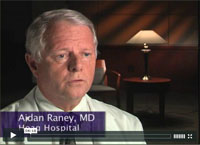The Ross Procedure
Overview of the Ross Procedure
The Ross Procedure was developed in 1967 by a British surgeon, Dr. Donald Ross, and has undergone refinements since the first operation. In the Ross procedure, the patient’s diseased aortic valve is removed and replaced with their own pulmonic valve. A homograft or porcine valve is then placed in the pulmonic position.
The Ross Procedure is an operation that is performed for aortic valve disease. The aortic valve ensures that blood is pumped from the left ventricle to the rest of the body. The two main types of problems with the aortic valve are aortic stenosis (narrowing of the valve) and aortic regurgitation (leaking of the valve). When aortic valve disease is present, surgery may be required to prevent further damage to the heart. Surgery will also help with symptoms, which include shortness of breath, heart failure, and fatigue with exercise. The Ross Procedure can be used to treat aortic stenosis or regurgitation.
Benefits of the Ross Procedure
The main advantage of the Ross Procedure is that the patient’s own pulmonic valve performs better in the aortic position than a replacement valve from a cadaver (homograft valve replacement) or mechanical valve. The aortic valve ensures blood flows forward from the left ventricle, which is the strongest part of the heart and pumps blood to the entire body. This leads to superior blood flow through the heart and less wear and tear on the heart structures. A homograft valve in the aortic position may need replacement every 10 years, but this time period is longer if it is in the pulmonic position. This means that the patient will have a longer period of time free from re-operation, where better durability leads to less frequent surgeries.
A second benefit when compared to mechanical aortic valve replacement is that blood thinners are not necessary. Blood thinners increase the risk of bleeding, and may lead to stroke or other medical problems. In addition, blood thinners can not be used in women who may become pregnant as they cause severe damage to an unborn child. The Ross Procedure is especially well suited to young individuals, who will benefit most from the longer durability and will not outgrow the valve (the valve can expand without developing problems). Other benefits include a smaller incidence of infection of the heart (known as endocarditis) with the Ross Procedure.
Disadvantages to the Ross Procedure
The Ross Procedure is technically much more demanding than conventional aortic valve replacement. This is important in patients who are older and have other health conditions. There is an increased risk of completing the surgery in the short term, and there is less benefit to the long term outcomes when compared to young individuals. For this reason, not all patients are a candidate for the Ross Procedure.
Although the procedure has been performed since 1967, only a few centers perform the operation. If you have additional questions, or would like to know if you are a candidate for the Ross Procedure, contact us to set up a consultation with one of our heart surgeons at (949) 650-3350.
Preparing for The Ross Procedure
Patients will meet with a heart surgeon before the Ross Procedure. The surgeon will review the patient’s medical history and discuss the planned surgery, as well as answer any questions that the patient may have. Prior to your surgery, you will have a full evaluation to minimize unseen problems during surgery. This includes lab tests and other procedures to ensure that there are problems during surgery. Please bring a list of all medications to your appointment before surgery. Your surgeon will evaluate all your medications and give you specific instructions on which medications to stop prior to your surgery. For more information, please see our section on preparing for heart surgery.
How is the Ross Procedure Performed?
Once you have arrived in the operating room, an anesthesiologist will put you to sleep with “general anesthesia,” and you will not remember the events during surgery or experience pain. A cardiac anesthesiologist has specialized training in heart surgery, and closely monitors consciousness and vital signs throughout the procedure. The anesthesiologist is also responsible for placing an endotracheal tube in the patient’s throat. This tube provides a secure airway between a ventilator machine that will do the work of breathing during surgery. The patient’s heart rate and rhythm are monitored throughout the operation with a continuous EKG machine.
Once the patient is asleep, the surgeon will make an incision down the middle of the chest and separate the breastbone, known as a sternotomy. The heart-lung machine is used to do the work of breathing and pumping oxygenated blood for the patient. The patient’s major blood vessels are connected to the heart-lung machine during surgery. The heart is then slowed with cooling solution and medications which allows the surgeon to perform surgery without any beating of the heart.
The heart surgeon will then access the heart and carefully remove the damaged aortic valve. After the valve has been removed, the surgeon will harvest the patient's pulmonic valve and replace the damaged aortic valve with the pulmonic valve. The pulmonic area is reconstructed, and a homograft valve is inserted into the pulmonic position. The surgeon carefully sews the heart up after the operation is completed. The heart is then warmed up until it begins to beat on its own, and the patient is taken off the heart-lung machine.
After the Ross Procedure
After the Ross Procedure is completed, the patient will be moved to the Cardiovascular Intensive Care Unit where specialized staff will closely monitor the patient. The patient is placed on a monitoring system that closely evaluates the heart rate, rhythm, and vital signs. Medications will be given to control for pain, nausea, and constipation. Please see our section on recovery from heart surgery for more information about recovery after the Ross Procedure.
Risks of the Ross Procedure
The Ross Procedure is a major surgical operation and certain complications may occur. The primary risks are stroke, heart attack, bleeding, infection, breathing problems, drug reactions, blood reactions, arrhythmias and possibly death. Your surgeon will discuss these and other risks with you before your operation. Fortunately these risks only occur in a small percentage of patients undergoing heart surgery.
Patient Experience: The Ross Procedure
 Please see our section on the Ross Procedure Patient Experience with Don Brady.
Please see our section on the Ross Procedure Patient Experience with Don Brady.
More Information on Ross Procedure
• Ross Procedure Information from CTS Net
• My Ross Procedure
 Email Article
Email Article 
